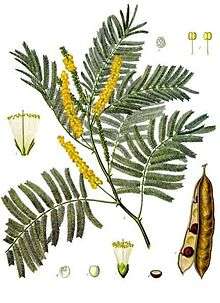Acacieae
| Acacieae | |
|---|---|
 | |
| Senegalia catechu | |
| Scientific classification | |
| Kingdom: | Plantae |
| Clade: | Angiosperms |
| Clade: | Eudicots |
| Clade: | Rosids |
| Order: | Fabales |
| Family: | Fabaceae |
| Subfamily: | Mimosoideae |
| Tribe: | Acacieae Dumort., 1829[1] |
| 5 or 6 genera | |
| |
Acacieae is a wide-ranging, polyphyletic tribe of legumes in the Mimosoideae,[2] that is native to the tropics, subtropics and warm-temperate regions. It includes five or six genera and some 1,450 species.
Relationships
In Bentham's 1842 circumscription of the subfamily Mimosoideae, Acacieae was one of its three constituent tribes, the others being Ingeae Benth. & Hook.f. and Mimoseae Bornn.[3] His Acacieae tribe of 1842 included many genera that were subsequently assigned to tribe Ingeae Benth. In 1875 however, Bentham narrowed his definition of Acacieae so as to include only Acacia Mill.[4]
The only morphological character of Acacieae used to distinguish it from the Ingeae, is the presence of free stamens (as in tribe Mimoseae).[3] In the Ingeae they are fused in the form of a tube, whereas in the Acacieae only a few species have the stamens fused at the base. Several characters of the foliage, seeds, seed pods, pollen and stipules are shared by the two tribes.[3] The flower morphology of Acacia s.l. has characteristics in common with the genera Leucaena, Piptadenia and Mimosa (tribe Mimoseae) and Enterolobium and Lysiloma (tribe Ingeae).[5]
The tribal position of monotypic genus Faidherbia A. Chevalier is equivocal.[2] It was included in the Acacieae by Vassal (1981) and Maslin et al. (2003), but Lewis & Rico Arce placed it in tribe Ingeae following Polhill (1994) and Luckow et al. (2003).[2][6] In the latter case tribe Acacieae may conform to genus Acacia s.l., pending the latter's relationship to other mimosoid genera. Faidherbia is troublesome as its stamens are shortly united at their base and its pollen is similar to some taxa in the Ingeae.[4]
Description
They are trees, shrubs or lianas, which may be armed or unarmed.[7] Where they have spines, these are modified stipules. In some, prickles arise from the stem's cortex and epidermis.[8] The leaves are bipinnate or are modified to vertically oriented phyllodes. A few have cladodes rather than leaves.[9] Extrafloral nectaries may be present on the petiole and rachis, and the pinnule tips may carry protein-lipid Beltian bodies.[8] The leaflets are usually opposite, and are carried on shortly stalks or are sessile. The heartwood is typically red and hard,[10] and the sap of various species hardens into gum.[9]
The inflorescences are dense pedunculate heads or spikes borne in axillary clusters, or are aggregated in terminal panicles.[7] The tetra- or pentamerous flowers are uniformly bisexual, or male and bisexual. Sepals are connate (i.e. fused) and valvate (i.e. not overlapping). The reduced petals are valvate, or rarely absent. The flowers have numerous exserted (i.e. protruding) stamens (>2x as many as the corolla lobes),[5] and their filaments are sometimes connate at their base (forming a short stemonozone). Male flowers of some neotropical species possess a reduced staminal tube (cf. A. albicorticata, A. hindsii, A. farnesiana and S. picachensis).[5] Flowers are usually yellow or cream-coloured, but may be white, red or purple.[9]
The ovary is sessile or stipitate (i.e. supported by a stipe), with many ovules or ovules arranged in two rows. The ovary is attached by a filiform style to a small, capitate stigma. The legume's endocarp is attached to the exocarp, but is otherwise very variable, and may be dehiscent or indehiscent. Seeds are usually elliptic to oblong and flattened to varying degrees. Seeds have a hard black-brown testa (i.e. seed coat) with a pleurogram, visible as a closed or almost closed O-shaped line. Some phyllodinous species have a colourful aril or elaiosome on the seed.[7]
References
- ↑ "Taxon: Tribe Acacieae Dumort. (1829) (plant)". The Taxonomicon. Retrieved 19 November 2015.
- 1 2 3 4 Lewis, G.P. "Acacieae Dumort 1829". Kew. Retrieved 19 November 2015.
- 1 2 3 Shinwari, Zabta K.; Jamil, Khansa; Zahra, Nadia Batool (2014). "Molecular systematics of selected genera of subfamily Mimosoideae-Fabaceae" (PDF). Pak. J. Bot. 46 (2): 591–598. Retrieved 23 November 2015.
- 1 2 Miller, Joseph T.; Bayer, Randall J. (April 2001). "Molecular phylogenetics of Acacia (Fabaceae: Mimosoideae) based on the chloroplast MATK coding sequence and flanking TRNK intron spacer regions". Am. J. Bot. 88 (4): 697–705. Retrieved 23 November 2015.
- 1 2 3 Rico Arce, M. de L.; Bachman, S. "A taxonomic revision of Acaciella (Leguminosae, Mimosoideae)". Anales del Jardín Botánico de Madrid. 63 (2): 189–244. doi:10.3989/ajbm.2006.v63.i2.7. Retrieved 20 November 2015.
- ↑ "Taxon: Genus Faidherbia A. Chevalier, 1934 (plant)". The Taxonomicon. Retrieved 19 November 2015.
- 1 2 3 吴德邻, Wu Delin; Nielsen, Ivan C. (2009). "Flora of China, 6. Tribe ACACIEAE" (PDF). Missouri Botanical Garden Press. Retrieved 19 November 2015.
- 1 2 Armstrong, W. P. "Botany 115 Vegetative Terminology, Modified Roots, Stems and Leaves". Waynes Word. Retrieved 19 November 2015.
- 1 2 3 "Acacia, Thorntree". EOL. Retrieved 22 November 2015.
- ↑ Nicholson, Paul T. (editor); Shaw, Ian (2000). Ancient Egyptian materials and technology (1. publ., repr. ed.). Cambridge: Cambridge Univ. Press. p. 335. ISBN 9780521452571.
External links
| Wikispecies has information related to: Acacieae |
| Wikimedia Commons has media related to Acacieae. |